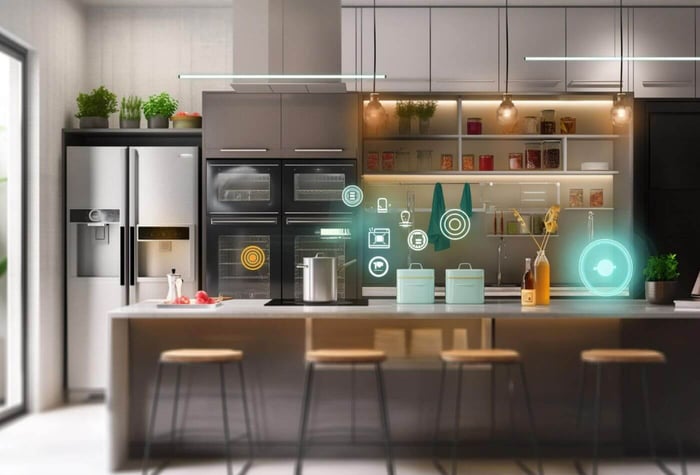
Low-energy smart locks: Revolutionizing Secure Living
Share
In an era defined by technological advancements, low-energy smart locks have emerged as a game-changer in the realm of home security. As tech professionals and enthusiasts, understanding the impact and functionality of these innovative devices is crucial. These locks not only enhance security but also offer energy efficiency, aligning with the growing trend towards sustainable technology. As we delve deeper into the world of low-energy smart locks, we will explore their benefits, technology, and potential applications.

The Importance of Energy Efficiency in Smart Locks
Energy efficiency is a critical consideration in today's technology-driven world. With the increasing number of smart devices in our homes, the need for energy-efficient solutions has never been greater. Low-energy smart locks play a pivotal role in this context. They operate on minimal power, ensuring that your home's security system remains functional without contributing to high energy consumption. This not only reduces your carbon footprint but also lowers electricity bills, making them an attractive option for eco-conscious homeowners.
Key Features of Low-energy Smart Locks
Low-energy smart locks come equipped with a range of features that set them apart from traditional locking systems. One of the most significant advantages is their ability to integrate seamlessly with other smart home devices. This integration allows for enhanced automation and control, enabling you to manage your home's security from anywhere in the world. Additionally, many low-energy smart locks offer biometric authentication, providing an extra layer of security by allowing only authorized individuals to access your home.
Moreover, these locks are designed to be user-friendly, with intuitive interfaces that can be easily operated via smartphone apps. This convenience is particularly appealing to tech-savvy individuals who prioritize accessibility and ease of use in their home security solutions.
The Technology Behind Low-energy Smart Locks
The technology underpinning low-energy smart locks is both sophisticated and efficient. At the heart of these devices is Bluetooth Low Energy (BLE) technology, which enables them to communicate with other smart devices while consuming minimal power. BLE is known for its low-latency communication capabilities, ensuring quick and reliable responses when the lock is engaged or disengaged.
Additionally, many low-energy smart locks utilize advanced encryption protocols to safeguard your data and prevent unauthorized access. This ensures that your personal information remains secure, providing peace of mind to homeowners concerned about privacy and data protection.
Applications and Benefits of Low-energy Smart Locks
Low-energy smart locks offer a multitude of benefits and applications. In addition to enhancing home security, they are particularly useful in commercial settings where energy efficiency and security are paramount. Businesses can leverage these locks to secure their premises while minimizing energy costs, contributing to a more sustainable and environmentally friendly operation.
Furthermore, low-energy smart locks are ideal for rental properties and vacation homes. Their remote access capabilities allow property managers to grant or revoke access to tenants and guests without the need for physical keys. This not only improves security but also streamlines the property management process.
For more insights into sustainable security systems, you can explore this article.
Challenges and Considerations
While low-energy smart locks offer numerous advantages, there are also challenges to consider. One potential concern is the reliance on technology, which can be susceptible to cyber threats. However, manufacturers are continually improving security measures to mitigate these risks, making smart locks more secure than ever.
Another consideration is the initial cost of installation. While these locks can be more expensive than traditional locks, the long-term benefits, including energy savings and enhanced security, often outweigh the initial investment.
Future Trends in Low-energy Smart Locks
The future of low-energy smart locks is promising, with ongoing advancements in technology and design. As smart home technology continues to evolve, we can expect to see even more integration with other IoT devices, allowing for seamless automation and control. Additionally, the focus on sustainability and energy efficiency will drive further innovation in this space.
For a broader perspective on green technology trends, you can visit this article.
Conclusion
In conclusion, low-energy smart locks are revolutionizing the way we approach home and business security. With their energy-efficient design, advanced features, and ability to integrate with other smart devices, they offer a compelling solution for tech professionals and enthusiasts alike. As we continue to prioritize sustainability and efficiency, low-energy smart locks will undoubtedly play a crucial role in shaping the future of secure living.
For more on eco-friendly energy solutions, check out this resource.

FAQs
Are low-energy smart locks secure?
Yes, low-energy smart locks are designed with advanced encryption and authentication protocols to ensure security. They are continually updated to protect against cyber threats.
Can low-energy smart locks save on energy costs?
Yes, these locks are designed to operate on minimal power, reducing energy consumption and lowering electricity bills.
How do low-energy smart locks integrate with smart homes?
Low-energy smart locks can seamlessly connect with other smart home devices using Bluetooth Low Energy technology, allowing for remote control and automation.
